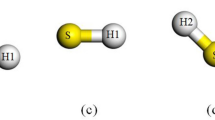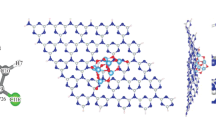Abstract
Context
SF6 gas has a strong greenhouse effect, and how to treat SF6 in an environmentally friendly way has been a hot topic of current research. In this paper, the adsorption behavior of SF6 on the surface of Pd-doped hydroxyl-terminated modified Ti3C2Tx (i.e., Ti3C2(OH)2) was investigated based on the density functional theory using two-dimensional MXene as the catalyst. The structures of different Pd-doped Ti3C2(OH)2 were analyzed and the most structurally stable doped structures were selected as the basis for subsequent calculations. A large number of adsorption configurations were constructed and geometrically optimized, and the adsorption energy, charge transfer, differential charge density, and density of states of the systems were calculated in order to analyze the gas–solid interactions and find the surface active sites; compared with the adsorption performance of undoped Ti3C2(OH)2 on SF6, it was found that Pd doping played a less inhibitory role in the adsorption of SF6 on the Ti3C2(OH)2 surface. The results of this study can provide theoretical support for the use of Pd-doped Ti3C2(OH)2 as a catalyst for the degradation of SF6.
Methods
In this paper, simulations of SF6 adsorption on Ti3C2Tx surfaces are based on density functional theory and are carried out in the Dmol3 module of Material Studio. To better describe the non-uniform electron density of the actual system, the PBE functional in the generalized gradient approximation (GGA) was chosen for the optimization of the structure of the gas–solid interface system and the calculation of the relevant electronic properties, combined with the Grimme dispersion correction in the DFT-D dispersion correction for the electron exchange correlation term. Because both Pd and Ti are transition metal elements, the mode-conserving pseudopotential DNP basis set containing relativistic effects was chosen for the electronic wave function expansion. In this paper, an all-electron model is used for the inner core treatment of gas molecules and a density generalized semi-nuclear pseudopotential DSSP is used for the solid surface treatment.









Similar content being viewed by others

Data availability
The data that support the findings of this study are available from the corresponding author, Fuping Zeng, upon reasonable request.
References
Kieffel Y, Irwin T, Ponchon P, Owens J (2016) Green gas to replace SF6 in electrical grids. IEEE Power Energ Mag 14:32–39
Maiss M, Brenninkmeijer CAM (1998) Atmospheric SF6: trends, sources, and prospects. Environ Sci Technol 32:3077–3086
Hwang CH, Lee BT, Huh CS, Kim NR, Chang YM, Ieee (2009) Breakdown characteristics of SF6/CF4 mixtures in 25.8 kV, in: 12th international conference on electrical machines and systems, Tokyo, JAPAN, pp. 1038-+
Reilly J, Prinn R, Harnisch J, Fitzmaurice J, Jacoby H, Kicklighter D, Melillo J, Stone P, Sokolov A, Wang C (1999) Multi-gas assessment of the Kyoto Protocol. Nature 401:549–555
Zhang X, Xiao H, Tang J, Cui Z, Zhang Y (2017) Recent advances in decomposition of the most potent greenhouse gas SF6. Crit Rev Environ Sci Technol 47:1763–1782
xiaoxing Z, Yi W, shuangshuang T, Fanwei C, Junyu H (2022) Effect of O2 on thermocatalytic degradation of SF6 by CePO4, High Voltage Engineering, 48 2152–2158
Hao X, Tie C, Hang L, Yi W, Xiaoxing Z (2021) Study on thermal catalytic degradation of SF6 waste gas based on phosphate. High Voltage Apparatus 57:180–185
Xiaoxing Z, Yalong L, Xiongxiong H, Hanyan X, Zhaolun C, Dachang C (2019) Simulation and experimental study on degradation of high concentration SF6 based on ultraviolet photocatalysis principle of titanium dioxide surface, High Voltage. Engineering 45:2212–2218
Fiori G, Bonaccorso F, Iannaccone G, Palacios T, Neumaier D, Seabaugh A, Banerjee SK, Colombo L (2014) Electronics based on two-dimensional materials. Nat Nanotechnol 9:768–779
Zhang X, Lei JC, Wu DH, Zhao XD, Jing Y, Zhou Z (2016) A Ti-anchored Ti2CO2 monolayer (MXene) as a single-atom catalyst for CO oxidation. Journal of Materials Chemistry A 4:4871–4876
Xu XD, Zhang YL, Sun HY, Zhou JW, Yang F, Li H, Chen H, Chen YC, Liu Z, Qiu ZP, Wang D, Ma LP, Wang JW, Zeng QG, Peng ZQ (2021) Progress and perspective: MXene and MXene-based nanomaterials for high-performance energy storage devices, Advanced Electronic Materials, 7
Nashim A, Parida K (2022) A glimpse on the plethora of applications of prodigious material MXene, Sustainable Materials and Technologies, 32
Shin H, Eom W, Lee KH, Jeong W, Kang DJ, Han TH (2021) Highly electroconductive and mechanically strong Ti3C2Tx MXene fibers using a deformable MXene gel. ACS Nano 15:3320–3329
Jiang Q, Lei YJ, Liang HF, Xi K, Xia C, Alshareef HN (2020) Review of MXene electrochemical microsupercapacitors. Energy Storage Mater 27:78–95
Feng Y, Linyan B, Yanping F, Mingjie M (2021) Research progress of preparation and catalytic hydrogen production performance of two dimensional MXenes. Henan Chemical Industry 38:1–6
Mengqi W, Shuyi W (2023) Application of MXene material in electrocatalytic reduction of CO2. Guangdong Chemical Industry 50:14–16
Chuanxi Y, Xiaoguang L, Chang G, Yonglin L, Wenping D, Lin L, Haofen S, Changqing L, Weiliang W Research progress of novel two-dimensional layered nanomaterials MXene-based photocatalyst in water treatment, Industrial Water Treatment, 1–19
Yang CZ, He HY, Jiang QG, Liu XY, Shah SP, Huang HJ, Li WH (2021) Pd nanocrystals grown on MXene and reduced graphene oxide co-constructed three-dimensional nanoarchitectures for efficient formic acid oxidation reaction. Int J Hydrogen Energy 46:589–598
Dibo W, Wei W, Ran Z, Haoyong S, Mingli F, Jing L (2021) Theoretical study on absorption of SF6/N2 decomposed products on the surface of ZnO⁃C3N. High Voltage Apparatus 57:104–111
Delley B (2002) Hardness conserving semilocal pseudopotentials, Physical Review B, 66
Zeng FP, Feng XX, Chen XY, Yao Q, Miao YL, Dai LJ, Li Y, Tang J (2022) First-principles analysis of Ti3C2Tx MXene as a promising candidate for SF6 decomposition characteristic components sensor, Applied Surface Science, 578
Xie Y, Kent PRC (2013) Hybrid density functional study of structural and electronic properties of functionalized Tin+1Xn (X = C, N) monolayers, Physical Review B, 87
Xianfei W, Linyu T, Panzhi L, Xiaoping C, Wanzhong R (2021) Application of Materials Studio software for gas adsorption in metal organic framework materials, Modern Chemical Industry, 41 34–38+43
Akbarzadeh R, Ayeleru OO, Ibrahim Q, Olubambi PA, Ndungu P (2022) Prediction of electronic properties of novel ZnS-ZnO-recycled expanded polystyrene nanocomposites by DFT, Heliyon 8
Ashraf R, Shehzadi Z, Mahmood T, Naeem S, Shehzadi N, Iftikhar S, Parveen Z (2021) DFT based investigations of BAWO4: electronic and optical properties, Physica B-Condensed Matter, 621
Funding
All the research work has been supported by the National Natural Science Foundation of China (Grant No. 52277161) and the Hubei Province Science Fund for Distinguished Young Scholars (Grant No. 2020CFA097). Express sincerely thankfulness here.
Author information
Authors and Affiliations
Contributions
Yiming Yan: writing — original draft, formal analysis. Fuping Zeng: resources, supervision, writing — review and editing. Long Wang: writing — review and editing. Xiangyu Wang: writing — review and editing. Kexin Zhu: writing — review and editing. Qiang Yao: supervision. Ju Tang: supervision.
Corresponding author
Ethics declarations
Competing interests
The authors declare no competing interests.
Additional information
Publisher's Note
Springer Nature remains neutral with regard to jurisdictional claims in published maps and institutional affiliations.
Rights and permissions
Springer Nature or its licensor (e.g. a society or other partner) holds exclusive rights to this article under a publishing agreement with the author(s) or other rightsholder(s); author self-archiving of the accepted manuscript version of this article is solely governed by the terms of such publishing agreement and applicable law.
About this article
Cite this article
Yan, Y., Zeng, F., Wang, L. et al. DFT study of SF6 adsorption by Pd-doped hydroxyl-terminal modified Ti3C2Tx MXene. J Mol Model 29, 350 (2023). https://doi.org/10.1007/s00894-023-05737-8
Received:
Accepted:
Published:
DOI: https://doi.org/10.1007/s00894-023-05737-8



